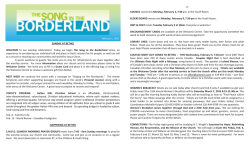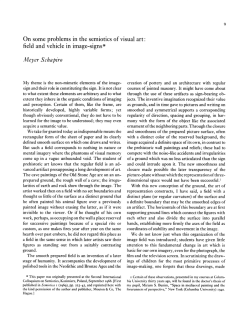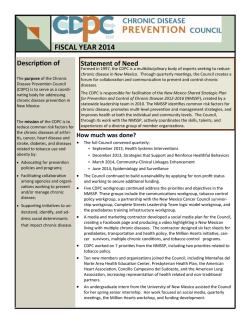
Quality and Methodology Information for International Trade in
Friday 30th January 2015 Issued by Office for National Statistics, Government Buildings, Cardiff Road, Newport, NP10 8XG Media Office 0845 6041858 Business Area 01633 456455 Lead Statistician: Michael Hardie Quality and Methodology Information General details Title of output: Abbreviated title: Designation: Geographic coverage: Contact details: International Trade in Services ITIS National Statistics UK including Northern Ireland 1 [email protected] Executive summary Exports Imports 2 This report relates to the International Trade in Services (ITIS) survey. The ITIS survey is conducted on both an annual and quarterly basis with both surveys measuring the value of transactions of UK businesses by country of origin and destination. The quarterly sample is made up of approximately 1,100 businesses and the annual sample made up of approximately 14,500 businesses. The survey data from both the quarterly and annual results are combined to produce the annual ITIS estimates and are used as a key data source to compile total trade in service estimates. In 2009, the ITIS survey incorporated the Film and Television survey which was discontinued as a standalone survey in 2008. The ITIS survey is also supplemented by information collected via the Annual Business 3 Survey (ABS) in relation to amounts paid or received for the imports or exports of services. Care is taken during the sampling and estimation process to avoid duplication between surveys. ITIS data are collected by both industry and product on a geographical basis, by collecting data for the countries to which services are exported to and where they are imported from. These data are 4 primarily used in the compilation of the services account for the UK’s Balance of Payments (BoP) , which in turn contributes towards the measure of UK Gross Domestic Product (GDP). The ITIS estimates are published annually and are freely available via the ONS website. This document contains the following sections: Output quality; About the output; How the output is created; Validation and quality assurance; Concepts and definitions; and Sources for further information or advice. 1 Output quality (This document provides a range of information that describes the quality of the output and details any points that should be noted when using the output.) 5 ONS has developed Guidelines for Measuring Statistical Quality ; these are based upon the five European Statistical System (ESS) quality dimensions. This document addresses these quality dimensions and other important quality characteristics, which are: Relevance; Timeliness and punctuality; Coherence and comparability; Accuracy; Output quality trade-offs; Assessment of user needs and perceptions; and Accessibility and clarity. More information is provided about these quality dimensions in the sections below. About the output Relevance (The degree to which the statistical outputs meet users’ needs.) 2 4 The results of the annual and quarterly ITIS survey, represent a key element of the BoP account and 6 2 . of Gross Domestic Product (GDP) . The results are published in detail in the ITIS publication The results from the ITIS survey make up approximately 50% of total exports and 38% of total imports of the Trade in Services Account for 2012. 8 As a condition of membership to the International Monetary Fund (IMF) , the UK is obliged to provide detailed trade in services information. The Statistical Office of the European Communities 9 (Eurostat) also requires a detailed geographical breakdown of trade in services products to allow construction of European Union (EU) aggregates. The geographical data also allow the analysis of bilateral asymmetries between member states to take place. As such, businesses taking part in the 10 ITIS survey are required to respond under the Statistics of Trade Act 1947 . The data are also used by Supply/Use Production branch within National Accounts. Tables are provided containing industrial and non-industrial service breakdown. They use the weighted flows of 2 the industry and product matrix data from ITIS for the analyses of industrial and non industrial services supplied by the ABS. Government and business users also use the data for economic assessment. The Department for 11 Business, Innovation and Skills (BIS) states that the ITIS survey is the only source of product detail for UK services and is essential for UK regional exports analyses. BIS also use the ITIS survey data to monitor the competitiveness of UK businesses and to gain a better understanding of the level of service exports. 12 In addition, The Scottish Government (SG) also show significant interest in the survey results to supplement Scotland’s Global Connections Survey (GCS), and the Department for Culture Media and 13 Sport (DCMS) use the ITIS data in one of their main outputs, The Creative Industries Statistical Bulletin. Respondents are selected by industry and employment and can also be identified by product or geography in order to produce various aggregates for analysis. 2 The 2011 edition of the ITIS publication contained for the first time a series of static and interactive infographics which were developed to enhance the overall look of the publication and make the product more appealing to users. Survey History 2 Prior to 1996, the ITIS survey collected only two products; royalties and other services; From 1996, the sample increased to 39 products, with an increase to the survey size. Each product has its own identifiable code. 2 In 2001, two additional product codes were introduced for Insurance Brokers and Management Charges. Insurance Brokers was taken over from another survey, whilst Management Charges was a subset of code 19 ‘other’. In 2001, following a recommendation from the 1998 Triennial review, the annual ITIS survey sample size was increased from 10,000 to 20,000 businesses. 2002 saw the introduction of three further codes, all subsets of code 19 ‘other’. These were Procurement, Publishing Services and Recruitment and Training. In 2005, as a result of a questionnaire review, ITIS codes were reviewed, and the number of codes increased from 44 to 51 as a result, including the collection of ‘Commodity Traders’. In 2007, the random sample element of annual ITIS which collected detailed product information was reduced from 13,500 businesses to 9,500 businesses. This was to accommodate the 3 inclusion of approximately 9,000 businesses sampled from the ABS where only a total imports and exports values is reported. This reduced the compliance costs for ITIS resulting in a total sample size of approximately 18,500 businesses. In 2009, The Film and Television survey was incorporated into the annual ITIS survey. In 2010, The Film and Television survey was incorporated into the quarterly ITIS survey. In 2010, both the quarterly and annual samples were optimally re-allocated. The quarterly panel increased by 350 businesses bringing the total sample size to approximately 1,100. To keep compliance costs static, the annual panel was reduced by approximately 1,400 businesses overall, keeping the annual and quarterly sample size constant. Changes to the Standard Industrial Classification (SIC) (from SIC 2003 to SIC 2007) were implemented into the ITIS annual 2009 and quarterly 2010 surveys. In 2011, work began to ensure that the surveys became compliant with Balance of Payments 15 manual 6 (BPM6) as required by Eurostat. In 2013, the revised ITIS questionnaire was dispatched to all quarterly respondents to collect 15 data as defined in the Balance of Payments manual 6 (BPM6) . The survey increased to 52 service products overall to comply with BPM6. In 2014, the revised ITIS questionnaire was dispatched to all annual respondents collecting data for the survey year of 2013. Timeliness and punctuality (Timeliness refers to the lapse of time between publication and the period to which the data refer. Punctuality refers to the gap between planned and actual publication dates.) 7 The ITIS Publication is published annually. This covers the reference period from the 1 January to 31 December. The latest publication was released on 30 January 2014 (13 months after the reference period) and includes results for 2013 calendar year. 16 For more details on ITIS releases, the UK National Statistics Publication Hub is available online and provides 13 months advance notice of release dates. In the unlikely event of a change to the pre-announced release schedule, public attention would be drawn to the change and the reasons for the change would be explained fully at the same time, as set out in the Code of Practice for Official 17 Statistics . The ITIS survey consistently meets publication deadlines, with a 100% record of on-time releases. 3 How the output is created The process for creating the outputs for the ITIS survey is detailed below in the following table: Sample frame There are two sampling frames used by ITIS. These are: Inter-Departmental Business Register (IDBR) - the IDBR covers businesses in all parts of the economy, except those that are not registered for Value Added Tax (VAT) or Pay As You Earn (PAYE) which can include very small businesses, the self employed, those without employees and those with a low turnover. The IDBR contains over 2 million UK businesses and is updated in real time from administrative data received from HM Customs and Excise. The IDBR is used by other government departments and is the main sampling frame for business surveys. Sample design Reference list - the reference list is made up of approximately 5,000 businesses which have been identified as businesses known to conduct trade in services. These businesses are classified on the reference list as either known traders or potential knowns. Businesses are identified through returns they have made on ONS business surveys such as Annual ITIS and on feeder questions on other ONS surveys that is, ABS. The ITIS sample is stratified by SIC 2007 at four digit level and employment. The nature of the ITIS survey means that sampling from the IDBR can be inefficient, as an overwhelming proportion of businesses would have nil returns because no trade in services was conducted. To address this, part of the solution has been to include filter questions on other large domestic business surveys such as the ABS. Currently, two questions are present on ABS questionnaires which specifically relate to ITIS and collect total amounts paid or received for the provision or receipt of service imports or exports. The ITIS samples are very fluid. Businesses can move between the annual and quarterly sample and vice versa depending on the level of their returns. This is outlined below: •Annual business Survey •collects only total imports and exports figures Businesses identified with large ITIS figures will be sampled by annual ITIS Businesses consistently reporting large ITIS values will be promoted to the quarterly panel •Annual ITIS Survey •collects full range of service products on an annual basis •Quarterly ITIS survey •collects full range of service products on an quarterly basis Businesses who experience a significant drop in ITIS can move back to the annual panel or out of scope of ITIS alltogether This is also supplemented by other known indicators of trade in service activity which include: sampling from the IDBR for industries where trade in services is common, these are known as high propensity industries; and known large respondents. 4 Sample size The sample size 18 for both annual and quarterly ITIS is as follows. Annual - approximately 14,500 businesses. Quarterly - approximately 1,100 businesses. The quarterly and annual samples are mutually exclusive so that no businesses would be sampled for both surveys for the same reference period. Sample exclusions NB: The annual ITIS publication incorporates the quarterly sample and also combines the data collected via the ABS. In total, annual ITIS results are based on data from approximately 24,000 UK businesses. ITIS sample businesses from a large proportion of the UK economy, however there, are a number of notable exceptions. ITIS excludes businesses which fall within the following sectors of the economy: Data collection travel; transport; banking; other financial institutions; higher education; charities; and a large proportion of businesses within the legal profession. Business within these sectors are excluded to avoid duplication in national accounts outputs. Data are sourced for these sectors from alternative means such as other ONS surveys or by use of administrative data. ITIS data are collected using paper questionnaires with manual input of data onto the system. In order to improve the efficiency of the survey operations and reduce the burden on respondents, Telephone Data Entry (TDE) is now being used for annual respondents to register a nil response. Response Data relating to the import/export of goods are excluded from this survey as they 19 are already collected in the estimates for Trade in Goods . However, merchanting, earnings from arranging the sale of goods between two countries outside the UK and where the goods never physically enter the UK, are included along with earnings from commodity trading. As with merchanting, the service element is calculated as the businesses profit minus the loss. Written reminders are issued to non-responders which are subsequently followed by telephone reminders in order to try and minimise non-response and any associated non-response bias. 10 The ITIS survey is covered under the Statistics of Trade Act 1947 meaning legal action can be taken against persistent non-responders, though ONS prefers to work together with businesses to produce the necessary information. Response rates are analysed on a weekly basis. The number of questionnaires received and cleared after validation are documented. Validation Data clearance Outliers Response rate targets are 85% for both annual and quarterly ITIS. Returned information is run through a series of checks to identify errors. These checks ensure that: 1. responses to individual questions are consistent within the questionnaire as a whole, that is, totals equate to the sum of the parts; and 2. the return is consistent with historical data from the business. Data clearance is the point at which data become error free. The target clearance rates for both annual and quarterly ITIS are 98% of the achieved response by the agreed close down date. The method of outlier detection and treatment is based on the principle of Winsorisation. The aim is to identify the sample observations which are felt not to be representative of unsampled companies. Outliered values are identified and modified prior to estimation using one-sided Winsorisation (since there are no negative values given as part of ITIS). 5 Imputation Imputation takes place when sampled respondents do not respond. Two methods of imputation are used by ITIS. Ratio imputation - this method is used where historical data for a non-responder are present. Data are taken from the previous corresponding periods and up-rated by the average growth within the same cell. Estimation Disclosure Means of ratio - this method is used for non-responders where no historical data are present. An imputed value is calculated by averaging returns from within the same cell as the non-responder. For the annual survey, Horvitz-Thompson estimation is used to produce estimates for the entire population from sampled data. Estimates are produced separately for each industry by employment stratum and aggregated to produce high level estimates. The exception is the data obtained from the ABS. Estimation is performed by multiplying design weighted responses by the imputation weight and aggregating to the appropriate level. Statistical disclosure control methodology is applied to ITIS survey data. This ensures that information attributable to an individual or individual organisation is not identifiable in any published outputs. The Code of Practice for Official 17 Statistics and specifically the Principle on Confidentiality set out practices for how we protect data from being disclosed. The Principle includes the statement that ONS outputs should ‘ensure that official statistics do not reveal the identity of an individual or organisation or any private information relating to them, taking into account other relevant sources of information’. More information can be found in 20 National Statistician’s Guidance: Confidentiality of Official Statistics and also on 21 the Statistical Disclosure Control Methodology page of the ONS website. Annual ITIS processing Cycle based on 2013 as the reference Period ITIS Statistical Bulletin published January 2015 Benchmark quarterly data using 2013 estimates November 2014 Deliver final results November 2014 Selection September/ October 2013 Annual time cycle Close for final results September/ October 2014 Despatch forms January 2014 Close for Provisional results April 2014 Deliver Provisional Results June 2014 6 Validation and quality assurance Accuracy (The degree of closeness between an estimate and the true value.) Sampling error Sampling error is the error caused by observing a sample instead of the whole population. While each sample is designed to produce the ‘unbiased’ estimate of the true population value, a number of equal sized samples covering the population would generally produce varying population estimates. Sample surveys are employed rather than censuses in order to balance the burden on businesses and cost of collection, processing and quality, against the relative accuracy of an estimate instead of a population value. Standard errors are an estimate of the sampling error and provide a measure of the precision of the estimate. A low standard error indicates a precise estimate. To aid comparison, the standard error is also expressed as a percentage of the total value. This quantity is called the coefficient of variation and it allows the standard errors to be put into context. A high coefficient of variation indicates a greater relative variation between the true population value and the estimated value from the sample. Non-sampling error In addition to sampling errors, there is the potential for non-sampling error that cannot be easily quantified. One potential source of non-sampling error is non-response, which relates to the failure to obtain data from some businesses selected in the sample. Another source of non-sampling error may be undetected deficiencies that may occur in the survey register and errors or inconsistencies may be submitted by the respondent when completing the survey questionnaires. The ITIS response rates and estimated standard errors are available in Appendix A of the ITIS 7 22 Publication and further information can be found within the Office for National Statistics . Coherence and comparability (Coherence is the degree to which data that are derived from different sources or methods, but refer to the same topic, are similar. Comparability is the degree to which data can be compared over time and domain for example, geographic level.) Coherence The ITIS survey is the only source of UK trade in services microdata, and as a result, ITIS data are an invaluable source for customers using these key economic indicators. ABS does have a filter question regarding imports or exports of services which was solely created to increase coverage of the ITIS survey. ABS only collect total trade in services, no breakdown by product or country is recorded. Comparability 2 9 The ITIS survey is designed in accordance with Eurostat regulations (European Commission (No.12461/03)) to ensure comparability across EU member states in the compilation of these Statistics. ITIS2 results appear in various ONS publications such as the Balance of Payments (BoP) and Pink book. The data contained within the BoP and Pink book publications represent the economy as a whole. Industries specifically excluded by ITIS that is, travel, transport and banking are included by the Trade in Services branch ensuring full coverage of Trade in Services data within the services account and can also be found in the UK Trade publication. In 2011, work began to implement recommendations made in the latest Balance of Payments 15 manual 6 (BPM6) which in respect of ITIS resulted in the questionnaire being thoroughly reviewed. New questions were added, increasing the total number to 52, and the descriptions surrounding all questions were reviewed. In some instances, the descriptions were enhanced to make it clearer to respondents what should be reported. The most notable change to the questionnaire was the rebranding of the ‘Royalties and Licenses’ section to ‘Intellectual Property’ which increased from four questions to six. Collecting the data according to the new regulations also meant a new production system was required. A full review carried out by ITIS specialists of all ITIS methods and their recommendations formed the basis for the new platform. 7 Concepts and definitions (Concepts and definitions describe the legislation governing the output, and a description of the classifications used in the output.) 10 The ITIS survey is mandatory and is collected under the Statistics of Trade Act 1947 . Detailed 14 SIC 2007 is available on the ONS website. Data is collected in accordance with the latest edition 6 of the Balance of Payments (BPM6) manual . Other information Assessment of user needs and perceptions (The processes for finding out about uses and users, and their views on the statistical products.) Data from the ITIS survey are used by a wide range of users. The key users are: 13 Department for Culture Media and Sport (DCMS) ; 25 British Film Institute (BFI) ; 11 Department for Business, Innovation & Skills . The Scottish Government 12 The UK Statistics Authority has reviewed this output in their report: Assessment of compliance with 26 the Code of Practice for Official Statistics: Statistics of International Transactions , which was published on 8 December 2011. This review recommended that ITIS estimates be designated as National Statistics on 3 May 2013. Sources for further information or advice Accessibility and clarity (Accessibility is the ease with which users are able to access the data, also reflecting the format in which the data are available and the availability of supporting information. Clarity refers to the quality and sufficiency of the release details, illustrations and accompanying advice.) The annual survey data are published in the publication entitled International Trade in Services 22 which is freely available from the Office for National Statistics . 3 Each publication includes a Basic Quality information section which is included in Appendix A, to 7 enable users to further understand the complexities of the ITIS survey. ONS's recommended format for accessible content is a combination of HTML web pages for narrative, charts and graphs, with data being provided in usable formats such as CSV and Excel. The ONS website also offers users the option to download the narrative in PDF format. In some instances other software may be used, or may be available on request. Available formats for content published on the ONS website but not produced by the ONS, or referenced on the ONS website but stored elsewhere, may vary. For further information please refer to the contact details at the beginning of this document. For information regarding conditions of access to data, please refer to the links below: 27 Terms and conditions (for data on the website) ; 28 Copyright and reuse of published data ; 29 Pre-release access (including conditions of access) ; 30 Accessibility . 1 Further queries can be addressed to the ITIS public enquiry team by email to: [email protected] . Useful links 4 Balance of Payments and National Accounts . 9 The European System of Accounts (ESA(95)) . 4 Balance of Payments 2004 Pink Book . 31 Organisation for Economic Cooperation and Development (OECD) . 8 References Title of Reference 1. ITIS Public Enquiry Team 2. International Trade in Services 3. Annual Business Survey 4. UK Balance of Payments 5. Guidelines for Measuring Statistical Quality 6. Gross Domestic Product 7. ITIS Publications 8. International Monetary Fund 9. The Statistical Office of the European Communities 10. Statistics of Trade Act 1947 11. The Department of Business, Innovation and Skills 12. The Scottish Government 13. Department of Culture Media and Sport 14. Standard Industrial Classification 2007 15. Balance of Payments manual 6 16. UK National Statistics Publication Hub 17. Code of Practice for Official Statistics 18. ITIS Sample Sizes 19. Trade in Goods 20. National Statistician’s Guidance: Confidentiality of Official Statistics 21. Statistical Disclosure Control Methodology 22. Office for National Statistics 23. National Accounts 24. Supply Use Group 25. British Film Institute (BFI) 26. Assessment of compliance with the Code of Practice for Official Statistics 27. Terms and conditions (for data on the website) 28. Copyright and reuse of published data Website Location [email protected] http://ons.gov.uk/ons/guide-method/methodquality/specific/economy/international-trade-inservices/index.html http://www.ons.gov.uk/ons/guide-method/methodquality/specific/business-and-energy/annual-businesssurvey/index.html http://www.ons.gov.uk/ons/taxonomy/index.html?nscl=Balance +of+Payments http://www.ons.gov.uk/ons/guide-method/methodquality/quality/guidelines-for-measuring-statisticalquality/index.html http://www.ukpublicspending.co.uk/spending_chart_1950_201 0UKb_11s1li011lcn__UK_Gross_Domestic_Product http://www.ons.gov.uk/ons/taxonomy/index.html?nscl=Internati onal+Trade+in+Services http://www.imf.org/ http://ec.europa.eu/eurostat http://www.legislation.gov.uk/ukpga/Geo6/10-11/39 https://www.gov.uk/government/organisations/department-forbusiness-innovation-skills http://home.scotland.gov.uk/home http://www.culture.gov.uk/ http://www.ons.gov.uk/ons/guidemethod/classifications/current-standardclassifications/standard-industrial-classification/index.html http://www.imf.org/external/pubs/ft/bop/2007/bopman6.htm http://www.statistics.gov.uk http://www.statisticsauthority.gov.uk/assessment/code-ofpractice/index.html http://www.ons.gov.uk/ons/about-ons/get-involved/taking-partin-a-survey/information-for-businesses/a-to-z-of-businesssurveys/annual-survey-of-international-trade-inservices/index.html http://www.ons.gov.uk/ons/search/index.html?newquery=Trad e+in+Goods http://www.ons.gov.uk/ons/search/index.html?pageSize=50&n ewquery=National+Statistician%E2%80%99s+Guidance%3A+ Confidentiality+of+Official+Statistics http://www.ons.gov.uk/ons/guide-method/bestpractice/disclosure-control-policy-for-tables/index.html http://www.ons.gov.uk/ons/index.html http://www.ons.gov.uk/ons/taxonomy/index.html?nscl=National +Accounts http://www.ons.gov.uk/ons/taxonomy/index.html?nscl=Supply+ and+Use+Tables http://www.bfi.org.uk/ http://www.statisticsauthority.gov.uk/assessment/assessment/ assessment-reports/index.html http://www.ons.gov.uk/ons/site-information/information/termsand-conditions/index.html http://www.ons.gov.uk/ons/siteinformation/information/creative-commons-license/index.html 9 29. Pre-release access(including conditions of access) 30. Accessibility 31. Organisation for Economic Cooperation and Development http://www.ons.gov.uk/ons/guide-method/the-nationalstatistics-standard/code-of-practice/pre-releaseaccess/index.html http://www.ons.gov.uk/ons/siteinformation/information/accessibility/index.html http://www.oecd.org/ 10
© Copyright 2026






